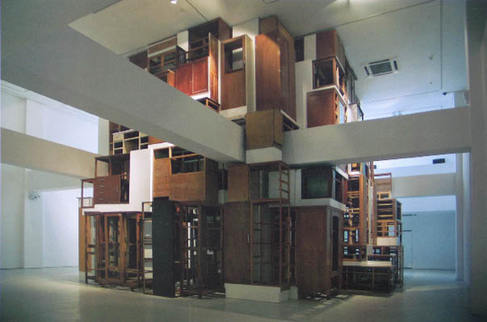Indefinable Wang Jianwei
“I use different mediums in my work and therefore, different associations are made between those mediums. I use film and video, theatrical performance, painting and sculpture. I’m not interested in any single concept of art. I studied painting for a long time but eventually I came to understand that art is not just about painting.”
Given how far many Chinese artists of his generation have come in defining their identity over the past 20 years, Jianwei is something of an exception in that he is still searching for ways to define contemporary Chinese art in general. In the process, he is literally inventing new systems and new approaches that integrate not only various mediums, but multiple disciplines such as sociology and anthropology.
Moving out of Jianwei’s studio and into a smaller attached storage room, he shows me several pieces of antique furniture that at first I identify as 1950s American industrial. However, he says this is a collection of Chinese Socialist furniture from the 1950s and 60s that he has been assembling for some time. I later learn that it was used in one of Jianwei’s installations entitled Distance inspired by The Monument to the Third International, a giant Constructivist tower conceptualized by the Russian avant-garde artist Vladimir Tatlin in 1917, but never erected.
|
 |
|
Distance, 2009. |
I am impressed by Jianwei’s depth of knowledge about international art and the distinct position he himself holds within the Chinese art world (he was the first Chinese artist to be invited to exhibit at Kassel’s Documenta: has exhibited at both the Venice and Sao Paulo Biennale, and in 2008 was awarded a prestigious Foundation for Contemporary Art individual artist grant).
In late 2009, as we sat over tea in a small kitchen off his studio, I asked Jianwei what he believed was the biggest problem in defining contemporary Chinese art today. “Everything is about time. People are aware that artistically between the 1950s and the early 1980s China was closed to the outside world, but realistically, we were also closed internally. As late as 1983, we didn’t have information about art from the outside world and information about ourselves wasn’t even readily available. That was a difficult moment for us but exciting as well and it caused a lot of questioning and experimentation. When more books became available, I was surprised to learn certain things about my own culture! It actually provided a unique way to look at all art at that moment. However, over the past four or five years, I have heard critics talk about the problem of dealing with ‘Chinese’ art as if it is still so very different. You don’t hear them talk about other art, like German art, in the same way. It’s very awkward and unnecessary I think. Why should we be different from the rest of the world at this time in our history?”
JON BURRIS is a recognized photographer and writer, and has authored seven books on contemporary art and photography. His photographs are a part of private and institutional collections internationally.

